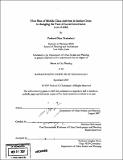| dc.contributor.advisor | Bish Sanyal. | en_US |
| dc.contributor.author | Chakrabarti, Poulomi Dhar | en_US |
| dc.contributor.other | Massachusetts Institute of Technology. Dept. of Urban Studies and Planning. | en_US |
| dc.date.accessioned | 2008-09-03T15:08:40Z | |
| dc.date.available | 2008-09-03T15:08:40Z | |
| dc.date.copyright | 2007 | en_US |
| dc.date.issued | 2007 | en_US |
| dc.identifier.uri | http://hdl.handle.net/1721.1/42271 | |
| dc.description | Thesis (M.C.P.)--Massachusetts Institute of Technology, Dept. of Urban Studies and Planning, 2007. | en_US |
| dc.description | Includes bibliographical references (p. 108-114). | en_US |
| dc.description.abstract | Neighborhood Associations, called Resident Welfare Associations (RWAs), have assumed an important role in public policy decision making in Delhi as the principal voice of the middle class. This represents a departure from the traditional role of these institutions that was restricted to the boundaries of their neighborhoods. This development also follows a Government of Delhi program, called Bhagidari, that institutionalized citizen government participation through these very associations. This thesis attempts to establish a relationship between middle-class activism, exemplified by the rise in neighborhood associations, and local governance in mega-cities using the case of Delhi. I observe that although implementation of Bhagidari did not change any formal political structures in the city, it led to friction between political representatives and the Delhi Government and Resident Welfare Associations. The media focus on the program and the administrative mechanism adopted in its implementation contributed towards the rise of RWAs. RWAs were able to influence public policy by forming citywide horizontal networks with other RWAs and bargaining with the State through the channels of the media. The various cases of activism reveal that this mobilization has been triggered by some form of privatization of service delivery which resulted (or was believed to result) in increase in user charges. The two RWA umbrella organizations that developed as a consequence of this mobilization point towards a change in the traditional 'apolitical' character of middle class in India. | en_US |
| dc.description.abstract | (cont.) Although both shared related opinions on public policy issues, one assumed a 'watchdog' of the State role, while another mobilized neighborhood associations to contest municipal elections. I discovered that neighborhood associations with pre-existing networks with government agencies were more likely to remain apolitical, while the ones without these social networks seek to become part of the government machinery through formal electoral channels. Policies on decentralization instituted by the Federal Government and the Bhagidari program have been instrumental in this change. | en_US |
| dc.description.statementofresponsibility | by Poulomi Dhar Chakrabarti. | en_US |
| dc.format.extent | 121 p. | en_US |
| dc.language.iso | eng | en_US |
| dc.publisher | Massachusetts Institute of Technology | en_US |
| dc.rights | M.I.T. theses are protected by
copyright. They may be viewed from this source for any purpose, but
reproduction or distribution in any format is prohibited without written
permission. See provided URL for inquiries about permission. | en_US |
| dc.rights.uri | http://dspace.mit.edu/handle/1721.1/7582 | en_US |
| dc.subject | Urban Studies and Planning. | en_US |
| dc.title | How rise of middle class activism in Indian cities is changing the face of local governance : [case of Delhi] | en_US |
| dc.type | Thesis | en_US |
| dc.description.degree | M.C.P. | en_US |
| dc.contributor.department | Massachusetts Institute of Technology. Department of Urban Studies and Planning | |
| dc.identifier.oclc | 231843465 | en_US |
